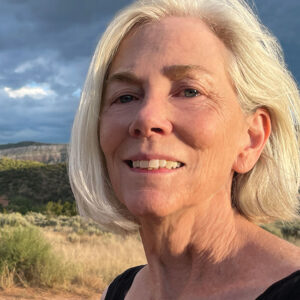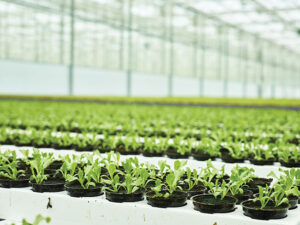
Duets: Greenhouse energy curtains
Peter Konjoian had the opportunity to sit down and talk with Julie Dean, vice president and third-generation co-owner of Wadsworth Control Systems in Arvada, Colorado, about energy curtains.
Julie has a Bachelor of Fine Arts degree from the University of New Mexico and learned business from hands-on work experiences with start-ups and growing up with generations of family businesses. She leads the financial team and oversees operations with her brother Gary Dean, who is the president at Wadsworth.
Q&A WITH JULIAN DEAN
Peter: Thank you for joining me today Julie. From one family business to another, tell us more about Wadsworth’s history and your family’s adventure in our extraordinary industry.

Julie: From the start, Wadsworth’s culture was open to new ideas and innovation. The company evolved from being a family of master electricians who did commercial and residential wiring to installing and maintaining traffic light controls. That experience made a natural transition to designing greenhouse automation.
In the early 1960’s my father, George Dean Jr., helped a friend who had been sleeping in his greenhouse and desperately needed an alarm. Dad said, “I think can help.” And he did. Word spread among growers as did Wadsworth’s capabilities. Soon, there were requests for irrigation, temperature control, vent automation and curtain systems. We listened to the growers and met their needs. Because of this, Wadsworth offered a full solution very early on.
That’s how Wadsworth became the first greenhouse automation company in North America. We remain dedicated to designing and building innovative climate systems. Today, my brother Gary, my sisters Patricia, chief executive officer, and Laurie, marketing lead, and I manage Wadsworth.
Peter: That’s a very interesting shift for your dad to make in the 60’s. Coincidentally, it parallels my father building his first greenhouse in 1960 to supplement his meat cutting career and the family farm effort. I think it’s important for all of us to share our family business stories Julie, it’s not just growers who run these types of businesses.
Master electricians, huh? They have my respect, I often say that I enjoy doing my own general electrical work in part because a circuit is wired either right or wrong. There’s no in between with electricity, you basically either get it right or you don’t. The scientist in me is drawn to that logical characteristic of electrical work.
Julie: That’s true Peter, though things like interference caused by incorrect wiring can be less definitive. Today’s networks require a new understanding of how digital information is transmitted, adding another layer to the electrical needs for each project.
It’s been a great honor to work with the families of generational growers, and like you, to have come from that same background. There’s a lot of trust and communication built through these shared histories.
Peter: I installed your energy curtain two years ago and have been using it as part of a larger case study I’m working on to share with fellow small growers. Keith Bemerer at Prospiant helped me work through the original decision making process in this column. I’m excited to discuss the curtain directly with the manufacturer today — you!
Let’s discuss my decision to install a curtain that serves double duty; primarily as a winter energy curtain and secondarily as a summer shade curtain. It sounded like a perfect solution to my research greenhouse needs but I observed something during the first two winters of operation that you can help me better understand.
By asking the curtain to perform double duty I gave back a portion of its heat retention potential. It all makes sense to me now, the fabric needs to be less opaque … more light transmission, in order to shade the greenhouse during the summer without being too shady. Help me understand how much winter fuel savings I gave back by asking the curtain to serve two masters, so to speak.
Julie: Thanks for choosing our curtain system for your study. Using a single curtain to provide two functions results in compromises, though
there are still a variety of choices allowing you to prioritize between heat retention and the amount of light passing through the curtain.
Heat retention for curtain fabric ranges from 15% to 70%, and shading runs from around 13% to 100%, which is total blackout. Not surprisingly, a curtain fabric that shades all light, with an opacity of 100%, has a high potential for the heat retention. However, blackout curtains have specific uses like addressing light pollution and providing for crops that require a balance of daylight and darkness to flower (poinsettia, cannabis). There are energy curtains that are not opaque and have the same high heat retention that might be a better choice.
Fabric is categorized to address specific needs: light diffusion, dual thermal control, energy saving with maximum light transmission, solar control, and light restriction. There are over 100 choices. We offer many different curtain fabrics to meet the growers needs.
Fabric manufacturers report percentage of shading with the first two numbers of a product’s name and the heat retention value using the last two numbers. For example, your greenhouse has Svensson’s Tempa 5557, so 55% of the light is blocked with heat retention of 57%. If you’d chosen Tempa 6560, you would have compromised the amount of light, from 55% shading to 65% shading, while gaining 3% in energy savings. You could have selected a fabric focused on maximum light transmission with high energy savings, like the Luxous 2945, but you would have lower heat retention. A curtain fabric in the 50/50 range works well for single systems. Tempa, the dual thermal line, is designed for serving both as a shade and energy curtain.
Your choice was a good one for your purposes. We have designed systems with two and sometimes three layers of curtains to make certain specific needs are met to the fullest capacity.
Peter: That’s a welcome perspective Julie, thanks for sharing the bigger picture. I feel better about my decision knowing that the opportunity the shade system gives me to continue research later in the spring and sooner in the fall outweighs the fuel savings I passed on.
Moving on, Wadsworth has placed a high priority on irrigation management. Tell us about your philosophy as a company in this arena and how your environmental control products address this challenge.
Julie: We’ve seen the challenges growers face, starting with the energy crisis in the 1970’s. Though energy
is still a factor today, water use is becoming growers’ top priority. We’re addressing this by programming options into the controller.
Watering schedules help growers make the most informed decisions on water usage resulting in consistent crops and watering tailored to the crop’s growth phase.
Peter: First, it’s refreshing to write with someone familiar with the energy crisis of the 70’s Julie…I’m usually dating myself to next generation horticulturists when I reference it. I concur that my top concerns in managing my greenhouse are energy consumption for heating, cooling, and lighting and water use efficiency. Most of my research for the past decade has focused on hydroponic systems and water management. It’s affirming to engage with you in this conversation to realize that we’re both addressing these concerns from our respective areas of expertise.
I imagine that as irrigation controllers evolve with complementary technology they are only as good as the sensors that activate irrigation events. Tell us how Wadsworth is integrating sensor technology into irrigation control and how sensor tech is advancing.
Julie: Sensors have driven precision responses in crop production. Using a collection of sensor readings can prevent over-heating, over- cooling, and over-watering. The more information the control has, the more astute the response. More sensors allow prioritization specific to the plant’s needs. Based on these settings, the equipment, from irrigation to ventilation and curtains, responds with very tight parameters. Sensor data is a valuable tool for growers to evaluate production times, crop quality and trends.
Using DLI (daily light integral) and VPD (vapor pressure deficit) accumulation readings allow for extra watering on hot days. A soil sensor allows for averaging air and soil temperatures resulting in better set point management. Our Seed control can average the soil temperature into the zone temperature, or factor soil temperature into VPD offering a better view of transpiration.
Growers who want more precise control over their irrigation cycles can also use a soil sensor for dry back, which ensures the soil has sufficiently dried between waterings. This can yield hardier plants with better root development, and even train certain crops to require less water.
Combining irrigation and fertigation offers a very precise, repeatable operation. Fertigation recipes can be tied directly to irrigation events to provide the best conditions for delivering nutrients. That allows growers to adjust nutrient injection based on live and historical EC/pH (electrical conductivity and level of acidity) values.
Seed, not an acronym, interfaces with all sensors and can manage many zones. It’s also our most user- friendly control. It has an accessible user interface like smart phones, but with deep functionality. What we hear from growers who upgrade to a Seed is, “How did I get by without this?” The Seed app and Wadsworth. Cloud allow access from anywhere at any time, graphing, data collection and multiple users. Access, more information, and informed responses from the controller, are all in response to requests we’ve received.









 Video Library
Video Library 


















